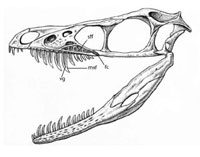Bird-Like Dinosaur Killed Prey with Venom
A bird-like dinosaur that prowled an ancient forest 125 million years ago used venom to subdue its prey, according to a new theory.

Sinornithosaurus's upper teeth resemble those of "rear-fanged" snakes which bite their prey and channel venom into the wound. The dinosaur probably fed on the abundant birds which inhabited what is now north-east China.
The work appears in Proceedings of the National Academy of Sciences journal.
Rear-fanged snakes are considered less dangerous than other venomous snakes. The fangs in these snakes do not inject venom, but instead channel the poison along a groove on the outer surface of teeth that pierce their prey's flesh.
Sinornithosaurus had upper teeth that were similarly long, grooved and fang-like, BBC reports.
"The ductwork leading out of the venom gland gave the venom a way to travel to the base of the teeth, where the venom welled up in the grooves," said study co-author paleontologist David Burnham of the University of Kansas Natural History Museum and Biodiversity Research Center.
"So when they sank their teeth into tissue of the victim, it allowed the venom, which was really enhanced saliva, to get into the wound," National Geographic News informs.
It turns out some venomous snakes and lizards use grooved teeth to deliver poison. Burnham thinks Sinornithosaurus did, too. Besides the teeth, another clue was a cavity in the jawbone where, he suggests, a venom gland could have been. He also found a channel leading from the cavity to ducts near some of the teeth.
These teeth are about 3 inches long. Unlike the hypodermic-type teeth of a viper, they're farther back, where our pre-molars would be. In much the same spot as those of rear-fanged snakes and lizards living now.
Burnham says the teeth and jaw of the animal were too frail for a "grab and gulp" strategy like big carnivores. Instead, it might have employed a "grab and hold" technique, something like the Gila monster of the American Southwest, NPR informs.
Subscribe to Pravda.Ru Telegram channel, Facebook, RSS!





